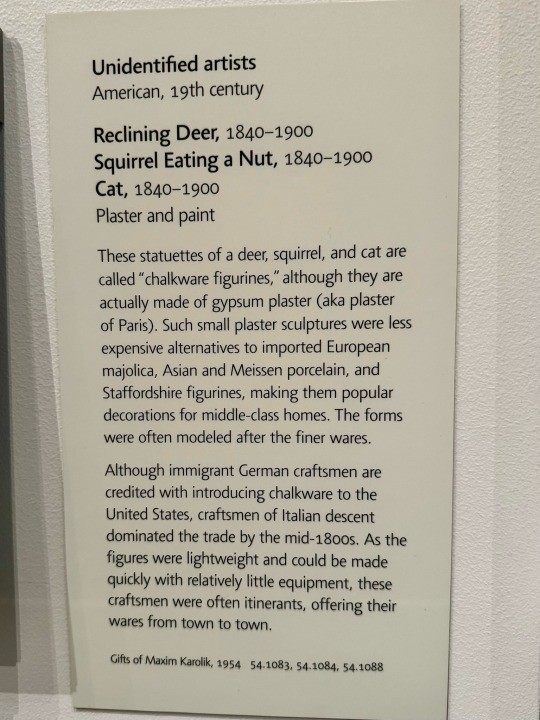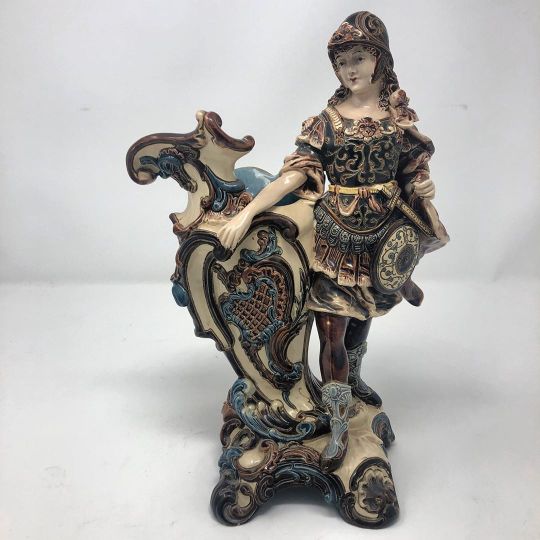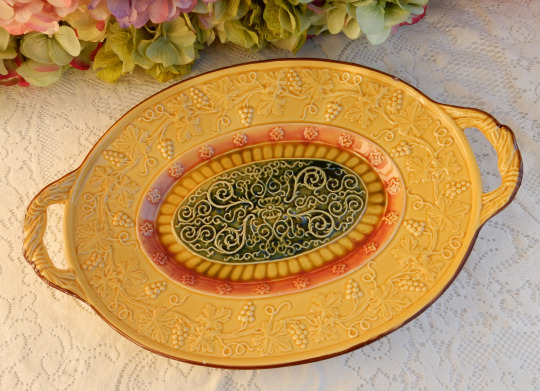#german majolica
Text

0 notes
Photo

Wilhelm Schiller & Sohn
majolica galleon-form centerpiece
Germany
late 19th century
#Wilhelm Schiller & Sohn#majolica#ceramics#centerpiece#antique#German#late 19th century#decorative object
45 notes
·
View notes
Text
#ThreeForThursday:


Unidentified American artists, c.1840-1900
1. Reclining Deer 13.65 x 11.11 cm (5 3/8 x 4 3/8 in.)
2. Squirrel Eating a Nut 16.19 x 9.21 cm (6 3/8 x 3 5/8 in.)
3. Cat 14.6 x 8.3 x 6.4 cm (5 3/4 x 3 1/4 x 2 1/2 in.)
Painted plaster (Chalkware)
Museum of Fine Arts, Boston display
“These statuettes of a deer, squirrel, and cat are called ‘chalkware figurines,’ although they are actually made of gypsum plaster (aka plaster of Paris). Such small plaster sculptures were less expensive alternatives to imported European majolica, Asian and Meissen porcelain, and Staffordshire figurines, making them popular decorations for middle-class homes. The forms were often modeled after the finer wares.
Although immigrant German craftsmen are credited with introducing chalkware to the United States, craftsmen of Italian descent dominated the trade by the mid-1800s. As the figures were lightweight and could be made quickly with relatively little equipment, these craftsmen were often itinerants, offering their wares from town to town.”
#animals in art#museum visit#19th century art#chalkware#figure#figurine#decorative arts#American art#folk art#deer#squirrel#cat#cats in art#trio#Three for Thursday#Museum of Fine Arts Boston
14 notes
·
View notes
Text






ANTIQUE PAIR MAJOLICA GERMAN FRENCH ITALIAN PLAQUES TILES MALE FEMALE ebay ladeda1
7 notes
·
View notes
Link
Check out this listing I just added to my Poshmark closet: Vintage - KARLSRUHE ART Pottery Vase.
0 notes
Link
Check out this listing I just added to my Poshmark closet: German Majolica Turquoise Ceramic Plates 8.75" Birds Grapes/Vines ZELL 1907-1928.
0 notes
Photo




A NEW MAJOLICA PLATE AND FLOWERS FROM THE GARDEN
Yesterday was quite hot so I went around the garden and quickly picked a few things, and equally quickly put them in a vase as I was going out. At a local vintage shop I found this interesting German majolica plate which brightened my day no end.
#German majolica plate#dahlia#old rose#'Mother's Love' pink rose#blue scabiosa#bright pink lychnis#pasque flower foliage#hellebore leaf
5 notes
·
View notes
Photo

Max Laeuger Majolica Vase ‘Zitronen’ 1910-1920.
(Source: artnet.fr)
#decorative arts#max laeuger#design#ceramics#majolica#vase#handpainted#german architect#german artist#jugendstil#zitronen
17 notes
·
View notes
Text

German majolica fish-dish and cover
late 19th century
Modeled in the form of a compressed ovoid coopered barrel, the cream glazed cover surmounted by a long fish, the body molded with a plaque reading "Marinirte Heringe", the underside stamped underglaze "Made in Germany".
Freeman’s
2 notes
·
View notes
Photo

And how about some poetry? A German made Majolica style piece of a soldier in a fine and fancy outfit, guarding a vase. Can you image how long it must have taken to get all the tiny details and precise painting? $110. #fvm39 (at Fremont Vintage Mall) https://www.instagram.com/p/CBjWZtNg1zq/?igshid=10wosei4wfzbl
1 note
·
View note
Text
#majolica#art nouveau#vintagehome decor#antique porcelain#GS Zell Majolica plate#iris plate#1930s german porcelain
0 notes
Photo

ART DECO MAN IN MOON CROWN TOP PERFUME BOTTLE
SCHAFER & VATER
Circa 1930
Gustav Schaefer and Guenther Vater founded the Schaefer & Vater Porcelain Factory in Volkstedt Rudolstad, Thuringa, Germany in 1890. Their aim was to make high quality porcelain.
In 1896 the business had sufficiently grown to purchase the List Porcelain Factory at Neuhaus. By 1910 the American firm of Sears Roebuck & Company had begun to import and distribute Schafer & Vater pottery into the United States.
The aim of Schafer & Vater was to produce a wide range of hard paste porcelain and was to include luxury items, figurines, and dolls' heads. They also produced soft paste porcelain in bisque items and Majolica and Jasperware were other produce lines. They produced many figural liquor bottles for distribution by pubs.
In 1913 Paul Schafer had taken over from his father and, working alongside Gunther Vater, built up a successful workforce of around 200 people, using 3 kilns. They advertised the manufacture of porcelain dolls' heads.
In 1918 the factory was destroyed by fire and they set up a new factory to resume production. The firm closed in 1962 and it is reported that in 1972 the East German government assumed full control of the vacant factory and their records and moulds were destroyed.
Schafer & Vater were better known for their comical and figural items. They manufactured these in teapots, jugs, creamers, bottles, match strikers, and planters, with a backstamp impressed with a crown above an 'R' in a star. 'Made in Germany' was sometimes stamped in black. The firm used a light blue glaze applied directly to the porcelain.
A hallmark of this pottery is the fine texture of the clay used in production. Mined locally, it was rich with kaolin and this resulted in a product with a velvety texture and very fine grain.
58 notes
·
View notes
Photo

Budapest
Párisi udvar/Brudern-ház.
In 1907 the Belváros Savings Bank acquired the property and organized a competition for the construction of its new, prestigious headquarters. They received forty-three submissions, a design by Flóris Korb and Kálmán Griegl was chosen as the winner. The bank's board of directors however decided to select a different architect, German-born Henrik Schmahl.
Construction started in 1909 and the building was completed in 1913, one year after Schmahl's death. The new building, also called Brudern House, was mixed-use, with a sumptuous shopping arcade on the two lower levels and room for offices on the upper levels. The arcade was named Párisi udvar (Parisian Court) as a reference to the original arcade. Today it is often written as Párizsi udvar (Párisi is the old spelling).
Exterior
Henrik Schmal created an unusual building in a mixture of different architectural styles, including Venetian Gothic and Renaissance, decorated with Art Nouveau and Oriental elements. The palatial exterior, clad with colorful Majolica tiles, is decorated with numerous ornaments and motifs. Sparkling white reliefs of figures set in neo-Gothic niches adorn the rooftop, while fifty statues protrude from the third floor. The two main towers, which reach a height of forty meters, are richly decorated with neo-Gothic sculptures and even grotesques.
The Parisian Court
The Parisian Court inside is even more impressive. The arcade, two levels high, has a vaulted roof made of colored glass and a striking hexagonal glass dome, designed by Miksa Róth. The arcade is decorated with cast-iron and sculpted wooden ornaments. The floors have beautiful mosaic tiles. There are balconies, windows with bar tracery, pediments and sculptures. You can also see reliefs of bees, symbolizing thrift, a reference to the bank that commissioned the construction. Henrik Schmahl sure wasn't in a thrifty mood when he created this masterpiece.
2 notes
·
View notes
Photo

Vintage Zell German Majolica Pottery Platter Scrolls Grapes Germany
http://www.ebay.com/usr/oldstreet
1 note
·
View note
Link
Check out this listing I just added to my Poshmark closet: Vintage - KARLSRUHE ART Pottery Vase.
0 notes
Link
Check out this listing I just found on Poshmark: Grapes Erphila Black Forest Plate German Majolica.
0 notes